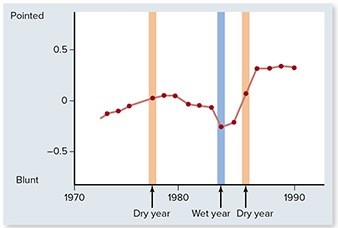 The pattern of wet years and dry years shown will probably move the population toward
The pattern of wet years and dry years shown will probably move the population toward
A. maintaining abundant variation in beak depth.
B. having two, distinct populations.
C. having intermediate size beaks.
D. all having larger beaks.
E. all having smaller beaks.
Answer: A
You might also like to view...
Member of the genus Cytophaga contribute significantly to the process of wastewater treatment.
Answer the following statement true (T) or false (F)
When Darwin covered the tip of a grass seedling with metal foil and then illuminated it from one side, what happened to the seedling?
A. It bent away from the directional light. B. It did not respond to the directional light. C. It grew toward the light, as expected. D. It waved back and forth. E. It wilted and died.
Which of the following processes does not use ATP?
A. active transport B. diffusion of oxygen into the blood C. muscle contraction D. cytoplasmic transport E. heat production
In a national park in Zambia, the percentage of tuskless female elephants increased from 10% in 1969 to 38% in 1989. What was the direct cause of this increase?
A) illegal poaching by ivory hunters B) fierce competition between male and female elephants for limited food resources C) periodontal disease D) The cause of this increase is unknown.